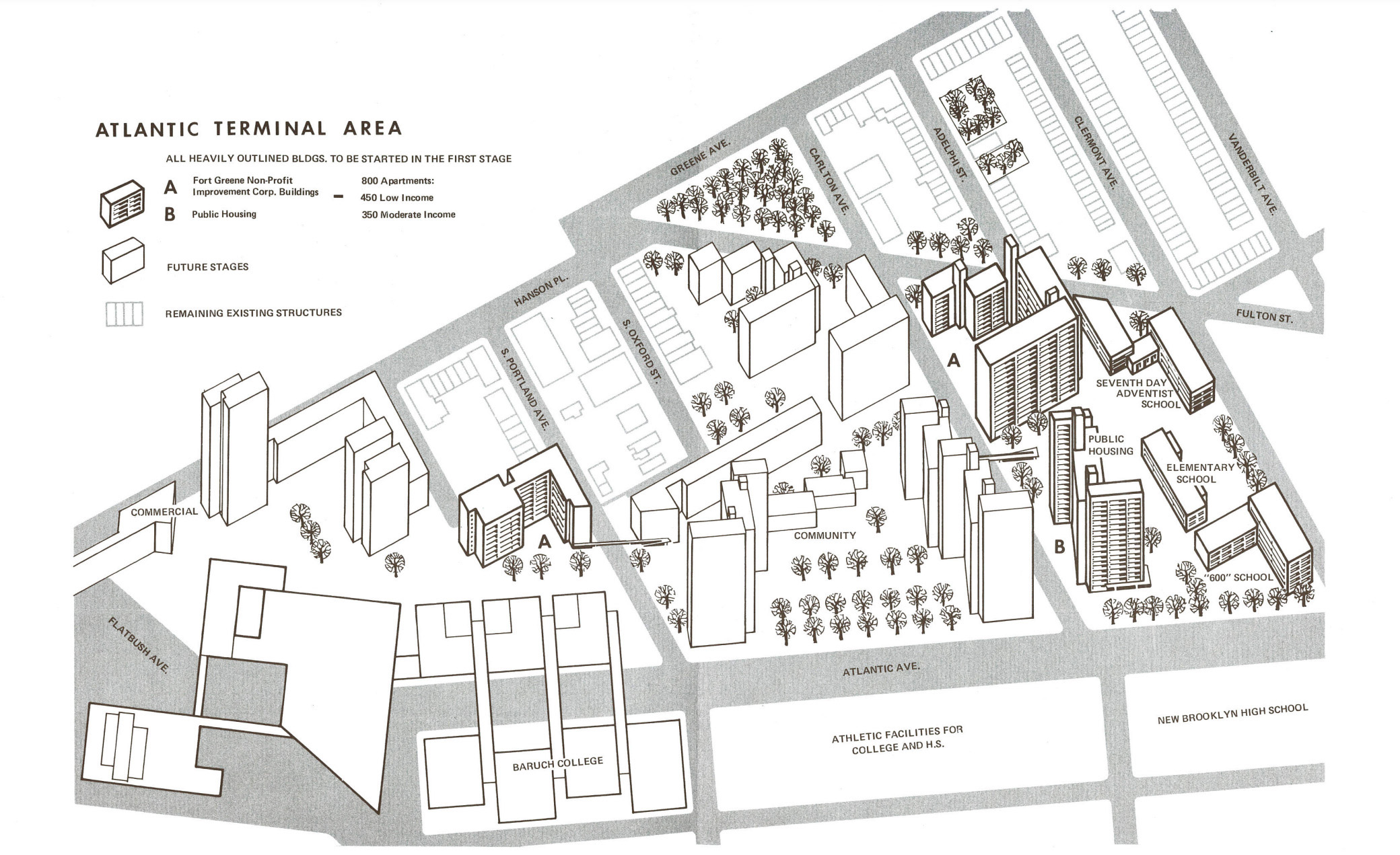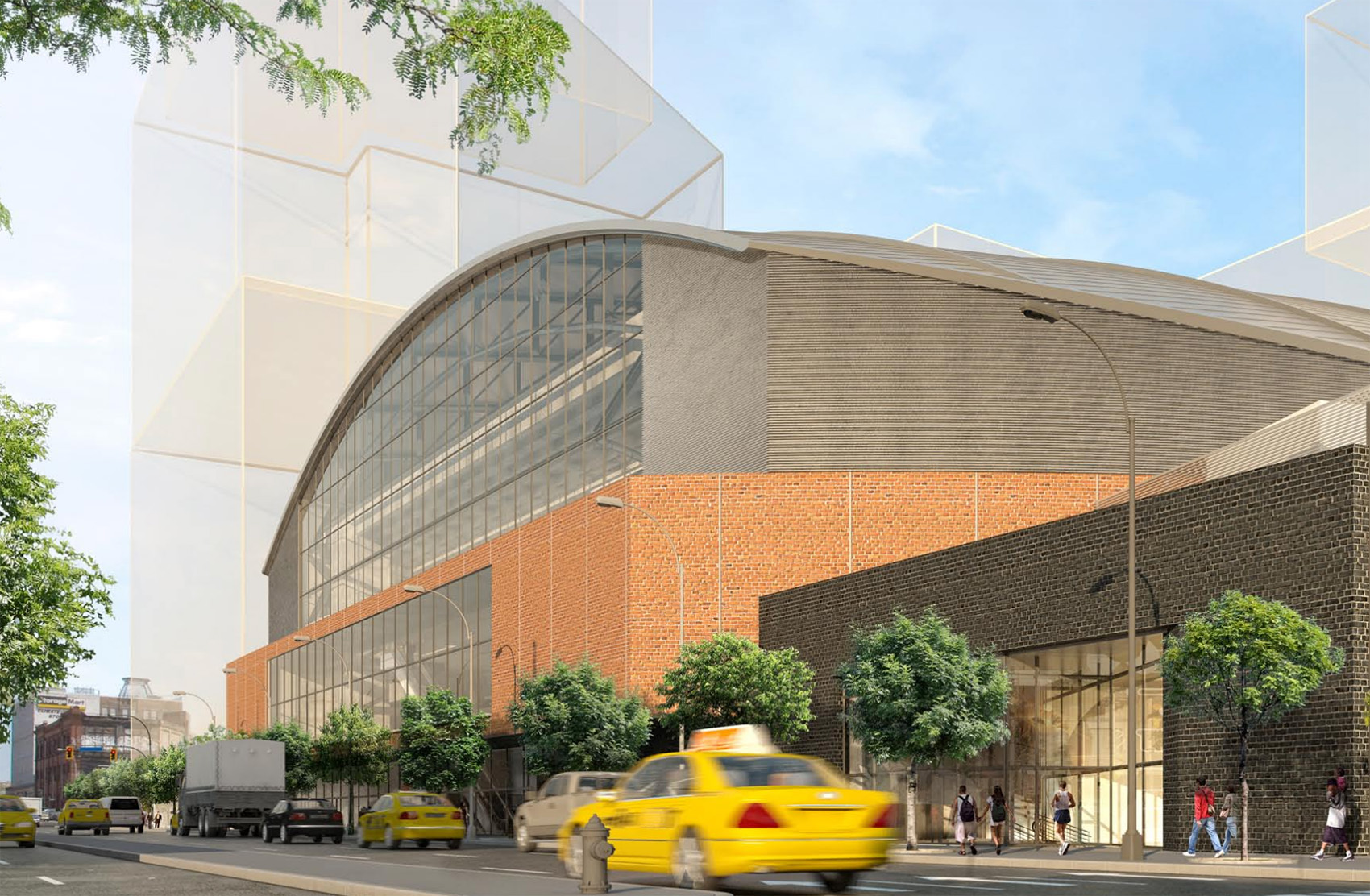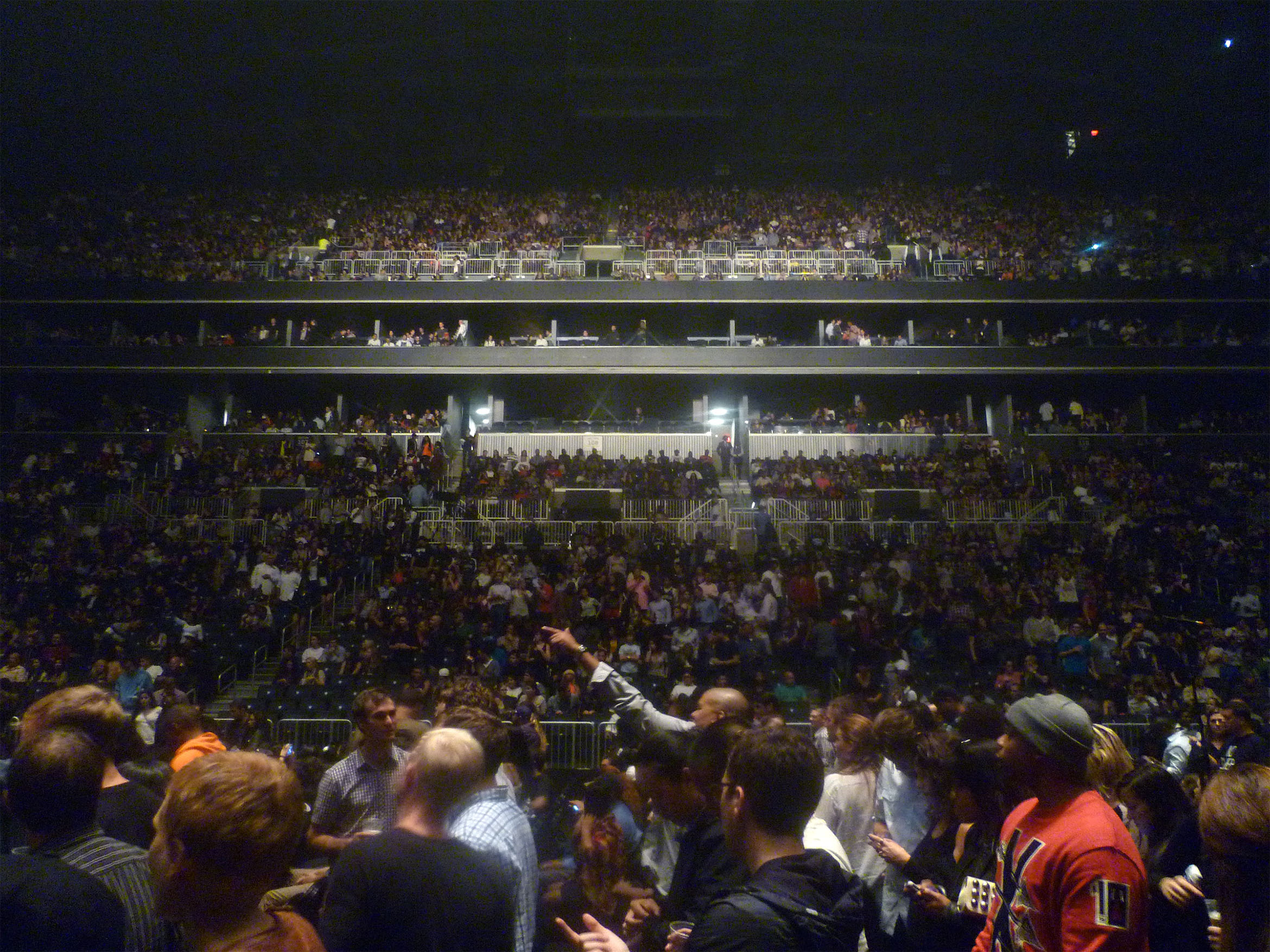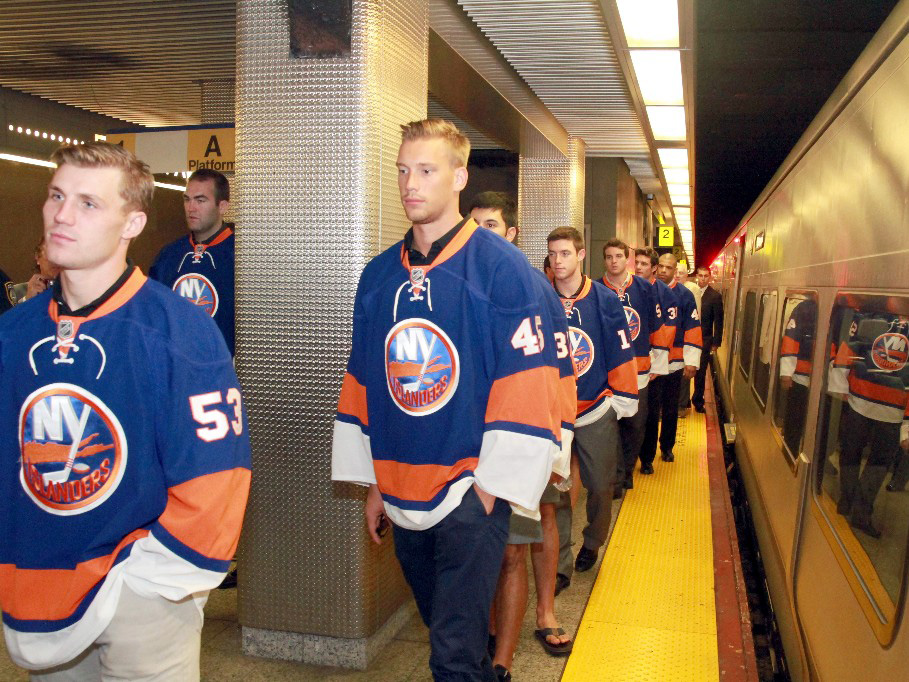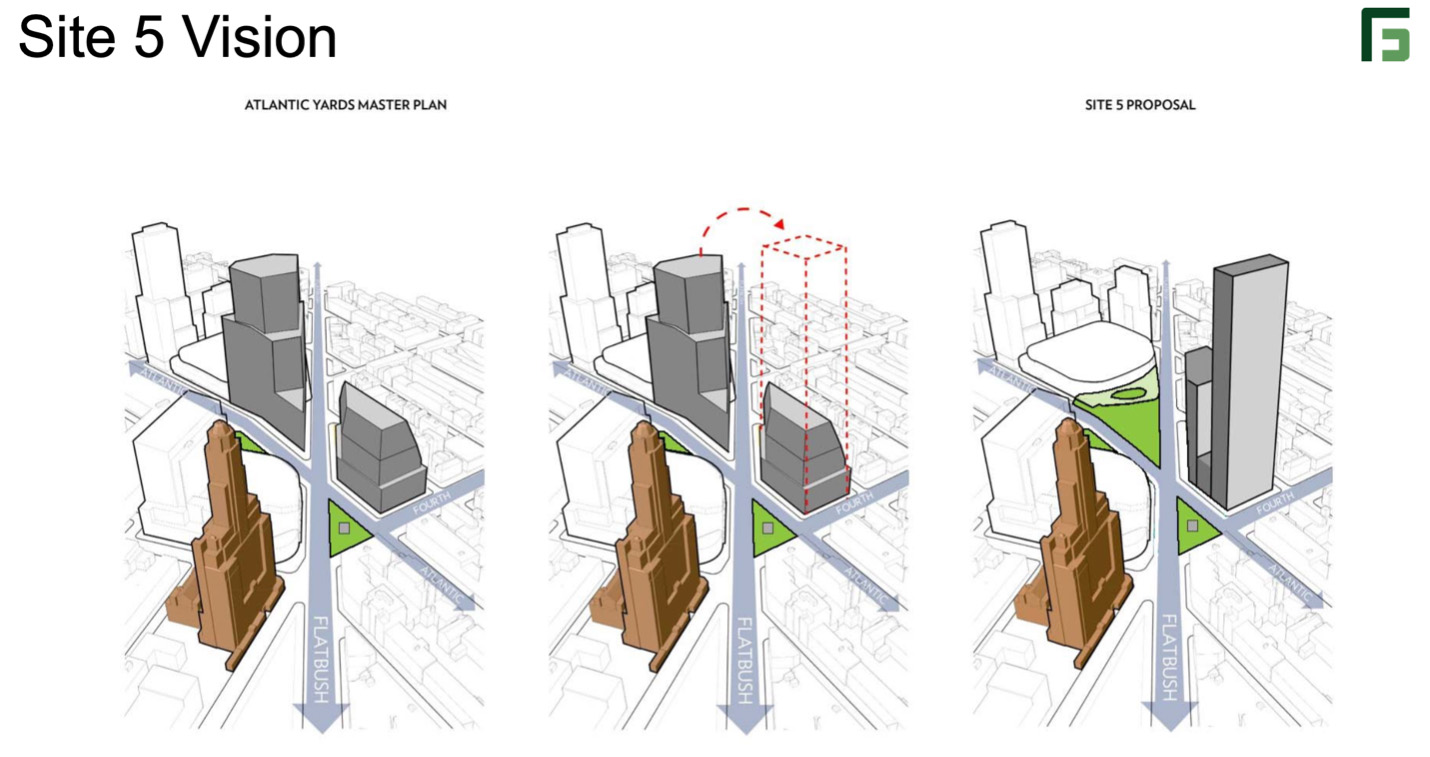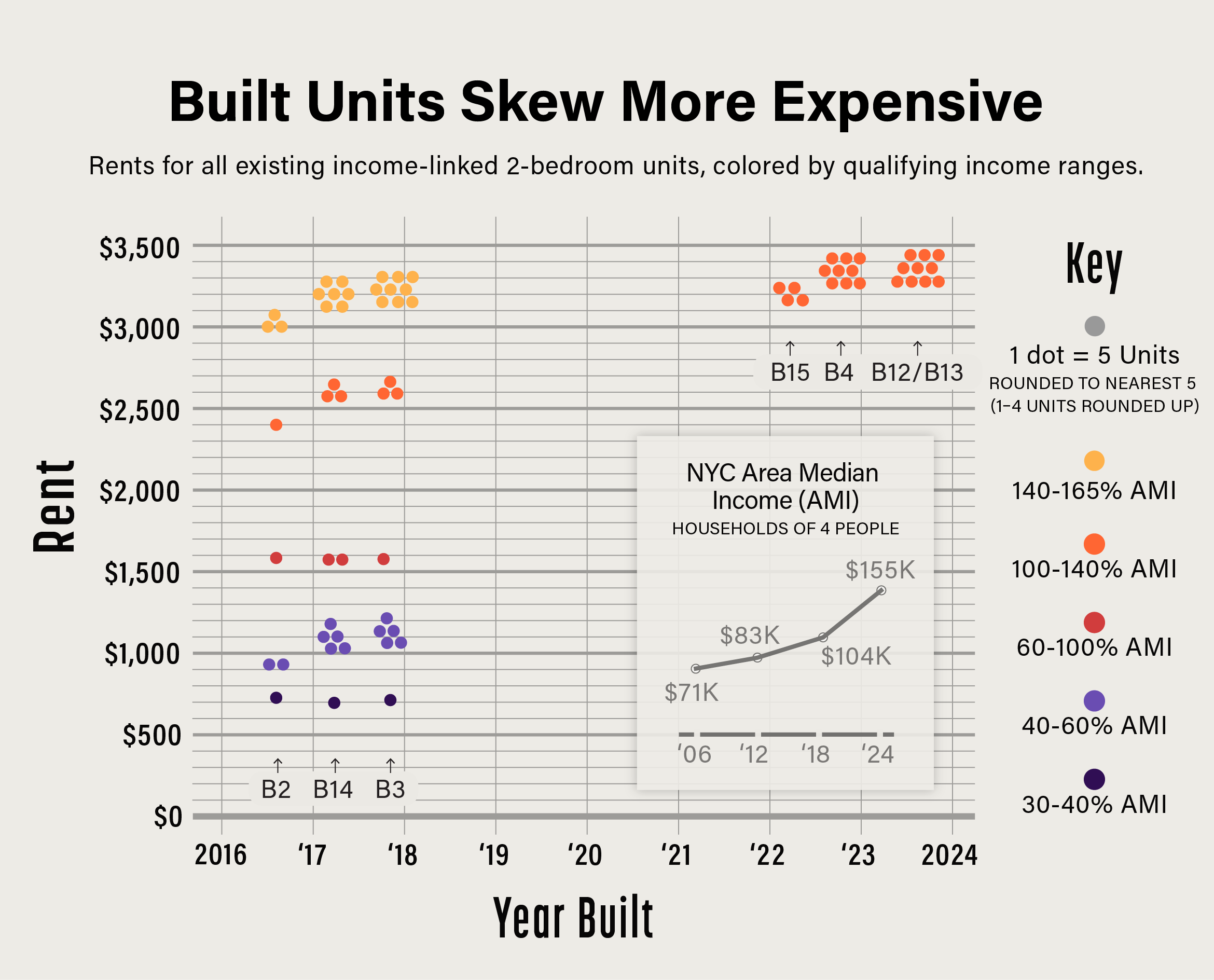
Celebrate ten years of Urban Omnibus and support ten more years of fresh, independent perspectives on citymaking with a donation today!
Celebrate ten years of Urban Omnibus and support ten more years of fresh, independent perspectives on citymaking with a donation today!
The initial proposal for Atlantic Yards, which promised housing, office towers, and a new arena and basketball team for Brooklyn, brought on a battle for the borough’s soul that made headlines and generated movie documentaries and investigative theater. At the end of 2023, the megaproject’s twenty-year anniversary brought news that the developer of the half-finished project was facing foreclosure and new doubts that Pacific Park (as it has been rechristened) would ever deliver on its commitments.
As Hudson Yards sees never-ending discussion and reevaluation, and the future of Sunnyside Yards prompts speculation, the attempt to build a new master-planned, mixed-use center over and around the sunken Vanderbilt Rail Yard near downtown Brooklyn has yielded Barclays Center and eight residential towers. Not yet built is the platform over the yard in question, a prerequisite for six more buildings including Atlantic Yards’ 876 remaining promised affordable housing units. In the absence of critical media coverage, and, increasingly, lamentably, the absence of local media at all, journalist Norman Oder has stayed on the Atlantic Yards beat, a self-appointed watchdog since 2005. From his Atlantic Yards Report blog — now Atlantic Yards/Pacific Park Report — to a Substack newsletter (a book manuscript is in progress), Oder has followed every move and uncovered nearly every obfuscation on or around the 22-acre site. That is important because, as attention has faded and the project has dragged on decades past its initial timeline, it’s been all too easy to bat away the promises of public benefits that accompanied significant public support for the $4.9 billion — and counting — project.
For those who haven’t been following closely the “saga unmatched in the annals of New York development,” we asked Oder for a synopsis of the drama in ten acts to date, with an evolving cast including out-of-town developers (from Cleveland and Shanghai), Frank Gehry, Jay-Z, Russian oligarchs, local politicians, judges, and public agencies. The details are hyperlocal, but the contours are broadly recognizable: public financing for private arenas, promises of affordable housing that isn’t very affordable or isn’t built, community benefits agreements that don’t bring community benefits, lackluster oversight. Read on for the story so far. It’s not over. . .
Announced in December 2003, Atlantic Yards was supposed to bring “Jobs, Housing, and Hoops” to Brooklyn within a decade: 16 towers plus an arena on a 22-acre site starting at the intersection of Atlantic and Flatbush avenues, where Downtown Brooklyn approaches Prospect Heights. Supporters thought Atlantic Yards would create a landmark mixed-use urban development that would vault Brooklyn’s prominence. Opponents feared it would overwhelm its neighbors and ride roughshod over democracy.
More than 20 years later, while the arena offers a new focal point, the project is less than half-complete, hardly the “center of it all.” The Barclays Center and the NBA’s Brooklyn Nets arrived in 2012. Eight towers have since risen as part of the development, renamed Pacific Park Brooklyn in 2014. But there is still no platform over the Metropolitan Transportation Authority (MTA)’s Vanderbilt Yard, the first step before building six large residential towers and five acres of publicly accessible open space. These would deliver about half the apartments promised and cure the purported “blight” of the below-grade railyard.
Proposed as a singular design by the architect Frank Gehry, who authored the master plan, buildings at Atlantic Yards (many still use the original name) have since been designed by several firms. The project, both embraced and feared as the “Manhattanization” of Brooklyn, has been eclipsed by the less-debated 2004 rezoning of Downtown Brooklyn, which has reshaped the borough’s skyline and delivered far more apartments, albeit few “affordable.”
Launched by Brooklyn-based developer Forest City Ratner, Atlantic Yards is now controlled, precariously, by Greenland USA, part of a Shanghai-based real estate conglomerate. A reckoning awaits; Greenland faces a foreclosure auction of its rights to build at six railyard sites. That auction has been postponed three times, as no bidder has stepped forward. A new developer could not simply start building. It would face costs for the construction of the platform, as well as potential fines for delayed affordable housing. That’s all pending renegotiation of project terms with Empire State Development (ESD), the gubernatorially controlled state authority facing the potentially contradictory task to both oversee and shepherd the project.
Despite Atlantic Yards’ stalled status, some focus on the achievement: having delivered major league sports and a striking venue, hailed by architecture critics, without detracting from neighborhood life as much as was feared or deterring development nearby. Others see developer hubris and broken promises, and what I have called a “culture of cheating.” Despite significant direct and indirect public assistance, including eminent domain and an override of zoning, the delayed — and increasingly pricey — “affordable” housing (so far 1,374 of the 2,250 promised below-market units) has hardly stemmed gentrification. Other civic commitments — such as a training program for construction jobs, in a much-hyped Community Benefits Agreement — have vanished.
What’s clear, long after Atlantic Yards was supposed to be finished, is how complex and risky such megaprojects can be, subject to economic and political cycles, legal challenges, and inevitable surprises. Delays not only compound financial risk, they trigger ever-rising baselines to calculate below-market “affordable” housing. It’s also clear that public officials did too little to guard the public interest, allowing developers to reduce promised benefits. Yes, the original developer Forest City Ratner and successor Greenland USA lost money, contra the expectations of the project’s detractors. But the Brooklyn Nets’ value has skyrocketed, thanks in part to a publicly supported arena. The public, however, has gained none of that upside. Today, with an ever-changing cast of public officials and developers’ representatives, attention — and institutional memory — has waned.
The Atlantic Terminal Urban Renewal Area (ATURA) is established in 1968, extending one block below Atlantic Avenue to encompass the three-block, sunken Vanderbilt Yard. A 1974 city study tasked with scouting potential sports facilities in Brooklyn suggests, among various locations, a parcel including two blocks of the railyard, which is used to store and service Long Island Rail Road trains, plus one block beyond the ATURA. City plans to develop over the railyard, including a Baruch College campus and athletic fields, are thwarted by costs for a platform.
Forest City Ratner, led by former New York City Consumer Affairs Commissioner Bruce Ratner, establishes Brooklyn prominence by developing the suburban-style MetroTech office complex. It also builds malls like Atlantic Center and Atlantic Terminal, across Atlantic Avenue from the future arena site. Forest City and its Cleveland-based parent, Forest City Enterprises, specialize in tricky public-private partnerships.
In 2002, longtime State Senator Marty Markowitz, bent on boosting borough identity and nostalgic for the Brooklyn Dodgers, becomes Brooklyn Borough President. Billionaire Mayor Mike Bloomberg is eager to rebuild after the September 11 attacks. His Deputy Mayor for Economic Development, Dan Doctoroff, later reveals that he considered Ratner’s Atlantic Yards proposal “a crazy risk, but, hey, it was his money.” (Not quite.)
Atlantic Yards plans are unveiled at Brooklyn Borough Hall, with Markowitz, Bloomberg, Ratner, Gehry, landscape architect Laurie Olin, and rapper-entrepreneur Jay-Z, who, despite only a small sliver of ownership, will be a crucial front man. The arena, near where the Dodgers once sought a new stadium, would house the relocated New Jersey Nets. Unlike sports venues ringed by parking, this would rely on public transit. An accessible green roof would provide the public with winter skating rinks and summer running tracks. “A Garden of Eden grows in Brooklyn,” New York Times architecture Herbert Muschamp rhapsodizes (unwisely), praising “an arena surrounded by office towers,” with a wedge-shaped soaring glass atrium, or “Urban Room,” serving both the venue and the flagship tower.
Ratner and associated investors buy the Nets, for $300 million. Project opponents, notably those in or near the proposed project footprint, organize as Develop – Don’t Destroy Brooklyn (DDDB). Council Member Letitia James sponsors UNITY, an alternative plan without an arena, that would extend streets to create smaller blocks, opening the railyard site to multiple developers. Before a contentious City Council hearing, Forest City commissions a report from sports economist Andrew Zimbalist claiming that, unlike most sports projects, Atlantic Yards would deliver huge tax revenues.
Forest City dangles buyouts, with gag orders requiring project support, to condo owners within the footprint; nearly all owners at one building, except DDDB leader Daniel Goldstein, agree to sell. “Bonanza,” pronounces a New York Daily News cover, but public funds, as I later report, reimburse Ratner’s seeming generosity. The Downtown Brooklyn rezoning, approved by the City Council, aims to incentivize office space, but permits large residential towers. The city resists entreaties to require some affordable units.
Forest City reveals that three planned office towers would become condominiums, decreasing space for the promised 10,000 office jobs. “Projects change, markets change,” executive Jim Stuckey will say. New York City and State sign a non-binding Memorandum of Understanding (MOU) with Forest City, promising capital contributions, tax breaks, and other assistance.
The developer signs another MOU with the New York Chapter of activist group Association of Community Organizations for Reform Now (ACORN), promising 50 percent of the rental apartments as affordable (or income-targeted), a seeming commitment to equity. Forest City then signs the city’s first Community Benefits Agreement (CBA) with ACORN and seven other groups, most focused on Central Brooklyn’s Black population and most with no track record, adding promises of job training, minority and women’s hiring and contracting, and more. Unlike with CBAs pioneered in Los Angeles, this private contract offers no public oversight. A required Independent Compliance Monitor will never be hired.
The MTA, belatedly, puts Vanderbilt Yard development rights up for bid; DDDB recruits rival developers. Forest City feeds the Times new Gehry designs before bids are revealed; challenger Extell has offered $150 million, to Forest City’s $50 million. The latter says its overall proposal is worth more. The gubernatorially controlled MTA agrees to negotiate exclusively with Forest City, which unlike Extell, has official blessing, controls some nearby property, and promises an arena.
A Pratt Institute report severely undermines Zimbalist’s over-optimistic math. (A DDDB analysis had previously found infrastructure costs low-balled.) The New York City Independent Budget Office says the arena would deliver only a small surplus. The reports don’t, however, assess the risk of delay. Forest City wins MTA approval after doubling its cash bid to $100 million. The Empire State Development Corporation (ESDC), starts the required state review process. DDDB, riding Internet savvy and local outrage about the project’s scale, impacts, and sweetheart deals, raises money for a legal fight.
The citywide urban advocacy group Municipal Art Society (MAS) proposes that Atlantic Yards be improved by moving open space to the curb, not eliminating streets, and respecting area context. To enable eminent domain, ESDC calls the 22-acre site blighted, citing weeds, cracked sidewalks, dubious crime statistics, and existing buildings’ failure to fulfill 60 percent of development rights. However, consultant AKRF’s report was limited to the project site itself, rather than, as its contract seemingly required, the larger, gentrifying neighborhood.
Aiming to improve but not block the project, MAS launches the coalition BrooklynSpeaks, with several Brooklyn neighborhood groups; they will later focus on deeper affordability and a local oversight structure. DDDB files a federal lawsuit challenging eminent domain. The state approves Atlantic Yards, estimating a ten-year buildout, to be completed in 2016.
The British bank Barclays is announced as the arena’s 20-year naming rights sponsor. Forest City executives acknowledge the project will take longer than expected. Documents pried from ESDC, after local legislators sue, show high project costs and rosy revenue estimates, suggesting financial precarity. State and City funding agreements give Forest City far more than ten years to complete Atlantic Yards, while allowing more costly apartments than ACORN negotiated.
DDDB’s lawsuits challenging the project’s environmental review and eminent domain fail, but a new eminent domain case is filed in state court. Ratner claims to “anticipate” project completion in ten years, by 2018. The national recession prompts Forest City layoffs and Olin’s departure. Still, federal officials grandfather in tax-exempt financing for the Brooklyn arena.
Ratner drops Gehry’s arena for a smaller, easier-to-finance venue, decoupled from the planned towers. (The green roof had already been “value-engineered” out.) Barclays renegotiates naming rights for the arena from $300 million to $200 million. Forest City Enterprises announces it will slow nearly all its development across the US.
At the state’s first legislative oversight hearing on Atlantic Yards, officials reveal Forest City has proposed a smaller replacement railyard and less cash up front. After the new Ellerbe Becket arena design, echoing their venue in Indianapolis, is slammed as a “monstrosity,” Ratner hires SHoP to wrap the exterior with a distinctive pre-rusted metal “skin.” SHoP also designs an oval oculus to over-gird a new plaza where the flagship tower had been planned. The ESDC and MTA approve new concessions to Forest City. The NYC Independent Budget Office now calls the arena a loss to the city.
An independent real estate analyst concludes Atlantic Yards will likely take at least 20 years, but the ESDC cites a market study supporting a ten-year buildout. Supplying key funds to Ratner, Russian oligarch Mikhail Prokhorov becomes majority owner of the Nets and minority partner in the arena operating company.
DDDB and BrooklynSpeaks (now sans MAS) file separate lawsuits challenging the state’s re-approval of the project. After a final eminent domain appeal fails, New York State approves tax-exempt bonds, repaid via PILOTS (payments in lieu of taxes), for the arena to be built on a nominally state-owned, tax-exempt site.
The state’s guiding Development Agreement offers generous deadlines, including 25 years to finish the project. Forest City’s arena groundbreaking includes Jay-Z and Barclays’ CEO. After his condo is condemned, activist Goldstein agrees to a judge-crafted settlement hastening his departure and thus arena construction. Forest City raises cheap capital via a federal investor visa program called EB-5.
The developer aims to build the world’s tallest tower using modular technology, stacking prefabricated apartment sections from a Brooklyn Navy Yard factory. A documentary film, Battle for Brooklyn, chronicles the DDDB-led crusade against Atlantic Yards. A state judge, combining the two extant lawsuits, orders ESDC to study the impact of project delays.
The Brooklyn Nets’ marketing plan, #HelloBrooklyn, invokes hip-hop and borough identity. The arena opens with eight concerts by Jay-Z, then stars like Barbra Streisand and Justin Bieber, though high operating costs curtail profits. Visitor access is eased by a Forest City-funded new passage from the plaza to the subway. Despite Barclays’ flawed layout for hockey, the New York Islanders announce a move from the outdated Nassau Coliseum in 2015. Forest City holds a groundbreaking for the first tower, 461 Dean (B2), with modular technology expected to save time and money on construction.
To cut its losses, Forest City sells 70 percent of the future project to Greenland USA, part of the Shanghai-based conglomerate Greenland Holdings. Greenland’s $200 million payment is well short of Forest City’s proportionate cost. As that sale proceeds, BrooklynSpeaks explores a lawsuit claiming the extended timetable would harm Black residents priced out and thus ineligible for neighborhood preference in the city’s affordable housing lottery. (DDDB, after 2014, is essentially defunct.) Forest City and Greenland raise $349 million in two new rounds of EB-5 fundraising.
The joint venture announces a secondary green roof for the arena, mainly aimed to muffle bass that, unnervingly, escapes the structure during bass-heavy concerts. (It’s not publicly accessible.) As the Greenland sale closes, a state agreement averts the threatened lawsuit with a new 2025 deadline for affordable housing: ten years earlier than the extended 2035 “outside date,” but long past the original ten-year promise. Also, officials promise two “100 percent affordable” towers, and a new advisory body, the Atlantic Yards Community Development Corporation.
Greenland renames the project Pacific Park Brooklyn. Modular partner Skanska, blaming Forest City for cost overruns, closes its factory; the firms sue each other. Forest City restarts the modular building construction on its own. State documents reveal the modular tower faced leaks and mold, requiring four floors to be gutted. Mayor Bill de Blasio hails the groundbreaking for “100 percent affordable” 535 Carlton, which, like 38 Sixth, skews toward middle-income units. Also rising: 550 Vanderbilt, a condo building. All are built conventionally.
The Islanders arrive, but an off-center scoreboard and limited-view seats provoke fans’ ire. Forest City sells its remaining stake in the Nets and the arena company to Prokhorov’s Onexim Group. (Promises of $15 Nets tickets lasted just one year.) Greenland Forest City floats plans for a giant two-tower project across Flatbush Avenue, on what’s known as Site 5, if the state allows a bulk transfer from the unbuilt flagship tower, which Gehry once dubbed “Miss Brooklyn.” The towers could have twice the bulk as allowed in the Downtown Brooklyn rezoning.
A refinancing of arena bonds saves the arena operator perhaps $90 million. Facing more losses and citing rising construction costs and increased competition from Downtown Brooklyn apartments, Forest City stalls Pacific Park construction. The developer admits the project should take until 2035. Having received too few applicants for middle-income units, 535 Carlton apartments are advertised outside the city’s “affordable housing” lottery.
Billionaire Joseph Tsai, co-founder of the Chinese company Alibaba, agrees to buy the Nets and arena company, in phases, for about $3 billion. As Islanders’ owners plan a new arena at Belmont Park on Long Island, the team returns part-time to the downsized Coliseum. Forest City gives up, to Greenland, all but five percent of its share in the remaining project. Forest City sells 461 Dean. Greenland sells three development parcels to local developers TF Cornerstone and The Brodsky Organization. Brodsky partners with Greenland on a fourth tower.
The Brooklyn Nets, surprisingly, sign stars Kevin Durant and Kyrie Irving, and later James Harden. Tsai completes his purchase, then buys the WNBA’s New York Liberty, moving them to Brooklyn. Curbed calls Barclays Center among NYC’s ten most important buildings of the past decade. The Public Design Commission’s Justin Garrett Moore has already called the arena one of the city’s “most important new public spaces and landmarks.” (Irony: the project likely wouldn’t have been approved without projected fiscal benefits from “Miss Brooklyn.”)
Before a BrooklynSpeaks session discussing project reforms, Greenland, facing a cash crunch in China, says it will start building the railyard platform in 2020. The Covid-19 crisis, however, shutters the arena and slows construction. After the police killing of George Floyd in Minneapolis, protests converge on the arena plaza, Brooklyn’s “accidental new town square.” Joe and Clara Wu Tsai pledge “$50 million over 10 years” in a Social Justice Fund for Brooklyn (though a full accounting remains murky). Tsai also monetizes the plaza and transit entrance, deploying new space for advertising. Contra plans for varied retail at the arena perimeter, its Flatbush Avenue flank houses just an expanded team store for the Nets and (later) Liberty.
The four newest towers contain 30 percent “affordable” units, but only for middle-income households, most earning six figures, enabled by the state’s revised 421-a tax break. BrooklynSpeaks explores a campaign for deeper affordable housing if Site 5 — the sole parcel remaining beyond the railyard — proceeds. Though Greenland again teases a platform start, nothing happens. The joint venture sells both 535 Carlton and 38 Sixth.
BrooklynSpeaks, with elected officials, protests the developer’s failure to build the long-forgotten “Urban Room” atrium. The state authority (formerly ESDC, now known as ESD), deflects questions about enforcing required fines, citing the plaza’s civic value. That raises doubts about whether ESD will enforce $2,000/month penalties for each affordable unit not delivered by May 2025, a deadline that can’t be met. Construction of a school in the base of the B15 tower finally starts.
New York State stalls on housing policies crucial to the project’s future, notably a successor to the 421-a tax break. Though the Nets lose all three superstars, rising NBA valuations let Tsai market a slice of the team and arena company at a reported $4.8 billion valuation. After a series of spot rezonings for new density in the blocks just past buzzing Vanderbilt Avenue, the eastern border of Atlantic Yards, city officials pursue the Atlantic Avenue Mixed-Use Plan. Three acres of Pacific Park are now completed; the remaining five depend on the as-yet unbuilt platform.
A foreclosure auction of Greenland’s rights to the six railyard sites, used as collateral for recent EB-5 loans, is repeatedly postponed. The State Legislature finally passes a new tax break for rental construction, but high interest rates remain a deterrent. It’s unclear if ESD will enforce the penalties for the unbuilt affordable housing, though waiving them could provoke outrage. ESD says it’s “focused on the successful buildout and completion of this project.” Details, and accountability, remain elusive. Original developer Ratner claims that not finishing the project is “not the end of the world.” Civic fatigue stifles public discussion of the contours and urban impact of the railyard buildout.
The views expressed here are those of the authors only and do not reflect the position of The Architectural League of New York.

